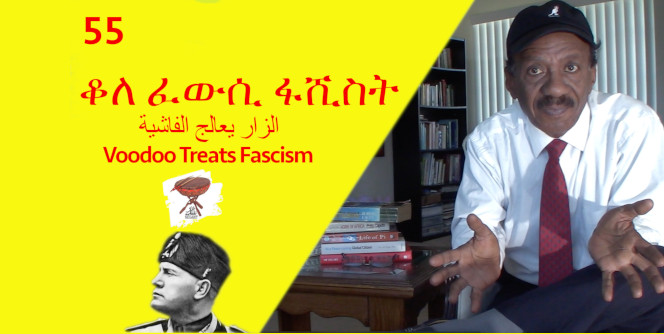Beneath The “Emamet”
 Not realizing beneath “Emamet” (traditional Eritrean Muslim’s turban), Ymma Zeineb was over excited to see Eritreans with “Emamet” in a meeting with the Ethiopian dictator, Mengistu Hailemariam, in Ethiopian TV. And, confided to her close friend “Adey Selas”, and said “N’mejemerya gz’ye nay add’na Emmamet ztekhednu ertrawyan r’eena” (this is my first time to see Eritreans with Eritrean “Emamet” in Ethiopian TV). Adey Silas nodded in agreement without voicing a single word. It seemed Adey Silas was also happy to see Eritreans discussing with the Ethiopian dictator. I had no chance to ask Ymma Zeineb why she was delighted. But I guessed she compared what she saw in the TV to Emperor Johannes’ era; when covering your head with “Emamet” or “Meq,naat” (traditional Eritrean Muslim women head scarf) was quasi illegal. She used to tell stories to her children of how it was dangerous at one stage in the Emperor’s reign in Eritrea to declare that one was a Muslim or practice Islam openly.
Not realizing beneath “Emamet” (traditional Eritrean Muslim’s turban), Ymma Zeineb was over excited to see Eritreans with “Emamet” in a meeting with the Ethiopian dictator, Mengistu Hailemariam, in Ethiopian TV. And, confided to her close friend “Adey Selas”, and said “N’mejemerya gz’ye nay add’na Emmamet ztekhednu ertrawyan r’eena” (this is my first time to see Eritreans with Eritrean “Emamet” in Ethiopian TV). Adey Silas nodded in agreement without voicing a single word. It seemed Adey Silas was also happy to see Eritreans discussing with the Ethiopian dictator. I had no chance to ask Ymma Zeineb why she was delighted. But I guessed she compared what she saw in the TV to Emperor Johannes’ era; when covering your head with “Emamet” or “Meq,naat” (traditional Eritrean Muslim women head scarf) was quasi illegal. She used to tell stories to her children of how it was dangerous at one stage in the Emperor’s reign in Eritrea to declare that one was a Muslim or practice Islam openly.
Ymma Zeineb’s excitement was drawn during the time when five Eritreans (Azmarinos used to call them jokingly in Italian language – Cinque per niente- the five useless persons) negotiated a regional autonomy type of settlement for the Eritrean case with Mengistu Hailemariam. They “claimed” that they represented Eritrean Lowlanders. Ripping the fruits of the strategic mistake of the “Cinque per niente”, the Ethiopian government hastily hatched a similar group representing Eritrean Highlanders, with the core aim to dilute the Eritrean struggle for independence. The short sighted action (though I disagree, some may argue that it was a better option had it succeeded than living under the today’s cruel PFDJ regime) of the “Cinque per niente” which I believe it was initiated at a wrong time ; when the Marxist regime in Ethiopia was almost collapsing, and for the wrong purpose. We all knew at that time, the Eritrean people with EPLF’s leadership were genuinely paying their precious life for the Eritrean independence.
The Ethiopian government received the regional autonomy settlement initiative with a lot of extravaganza and fanfare: public demonstrations, public meetings, and radio and TV interviews. But Ymma Zeineb, as many other Eritrean mothers, did not realize what was behind the fanfare, and beneath the “Emamet” of the “Cinque per niente”. She thought it was for the betterment of the Eritrean people; a compensation for the ugly days of Emperor Yohanes’ period, or a reward for her daily prayer “Nezom deqqna Rebi Yen’s’rom” (May God help our sons /Freedom fighters succeed in their aim). She didn’t know it was a gathering to sell out the Eritrean case. Fortunately it did not take Ymma Zeineb long to comprehend the situation; though she was not lucky enough to find her sons besides her to enlighten her on what was happening. She did not stop her daily pray “Nezom deqqna Rebi Yen’s’rom”, and the Eritrean people also did not stop their struggle. The good news was that the conspiracy failed by the Eritrean people’s unity. The truth prevailed and Eritrea was liberated by its own sons and daughters.
It has become customary for the PFDJ regime to organize endless festivals hopping to find naïve people, to sell them the “Emamet”. The Eritrean Festival 2011 was a perfect example. As usual there was a wing “Kushet Biherat” in the festival where Eritrean communities demonstrated their cultures. Some green Eritreans might have felt happy, rather excited (like Ymma Zieneb) by seeing their region’s colorful cultures in such a Festivals on ER TV. For instance, the Hamassien might have felt good when they watched their traditional dances ; the Senhit and the Gash people might have smiled when they saw their traditional homes; the Barka and Sahil might have been glad when they spotted their traditional coffee; the Akeluguzai might have felt comfortable when they listened to their traditional poems; the people of Semhar and the Afaris might have been relaxed when they noticed their traditional dresses; the Seraye might have been at ease when they witnessed their famous drum ( Kebero) beating ; the Rashaida might have been ecstatic when they set their eyes on their unique dances.
The above are good enough to make many cheerful. But it is wise to see beyond these attractive scenes that are watched live on TV. The autocratic regime in Asmara wants us to see our communities in terms of their cultural attires, foods, dances and so on, as if they were lifeless exhibits. And I am not against cultural festivals; but it is naiveté not to visualize what is beneath these traditional dresses, foods, songs and dances; in short “Beneath the Emmamet”? The end result should not only be appreciating these cultures, but understanding how the Barka, Akeleguzai, Senhit, Sahil, Hamassien, Semhar, Gash, Serayes and Afar are living back in their villages, towns and provinces—verifying whether they are being regarded as human beings with feeling and needs, whether their children are living in freedom, peace and security, whether their sons and daughters are free to work freely, whether they have enough food to eat, is what must be the yardstick. I am not here to turn cultural festivals and Eritrean communities in to enmity. I appreciate festivals irrespective of who organizes them. However, I believe that there are questions that need to be asked beyond the festivities and partying occasions: what are the agonies that these communities are experiencing in their respective areas?
In the recent Festival 2011, as usual, the PFDJ regime has focused on the celebratory part of the event by interviewing selective audiences and Diaspora Eritreans in the ER TV. The typical question for the Diaspora was, how they felt about the festival. Again, the customary reply was one of elation for being able to share the occasion with different cultures. But what these communities expected from the Diaspora was to share with them not only their culture, but also their pains. They wanted them to understand that they are human beings with feeling, not animals in a zoo or in national parks for tourists to enjoy. Nonetheless, the type of questions that ERE TV reported asked the Diaspora were questions one would ask a typical tourist: how did you feel about the occasion? And the replies matched the questions: I enjoyed it! Those who have arrived from the West confirmed that similar festivals were not held in the countries that they came from. But they forgot to mention the priceless thing: freedom, peace and security. In their host countries, they enjoy what Eritreans are deprived of in their own country. Sometimes I wonder what their responses would have been had the Diaspora visitors been asked: would you be willing to swap places with Eritreans and live in Eritrea ,even for few year? Would you be willing to stay in Eritrea with the communities whose cultural shows you so much appreciated in the festival? I would be astonished if the reply would not be similar to our old saying “Til’Yan Yffatewu’mo gna bebyati’oum” (Italians love each other, but each one eats from his own plate.) You find the Diaspora Eritreans in festivals and they are tourists like any other tourists in the world; they want to share their (brief) leisure time with their hosts, not to share life (good and bad) with them.
Anyway, by now the Diaspora Eritreans should not be betrayed by the Emamet anymore. Yet I am willing to understand, if I came across people who do not bother to see beneath the Emamet provided they were graduated from PFDJ University. But for those whose “color blindness” is due to naiveté; I am ready to help them by finding somebody who could help them reveal what is beneath the Emamet. The next step then would be to join the peace loving Eritreans in the struggle to replace the autocratic regime in Asmara, with a democratic one. I hope the next festival will be in the re-librated democratic Eritrea where its people would enjoy their God-given rights in their villages, cities, town and provinces. Only then would it be appropriate for the Diaspora Eritreans to mix their leisure time with different cultures in festivals. It is time to learn to explore what is “beneath Emamet”.
Ramadan Mubarak!
For comments- Meftih2011@yahoo.com



Awate Forum